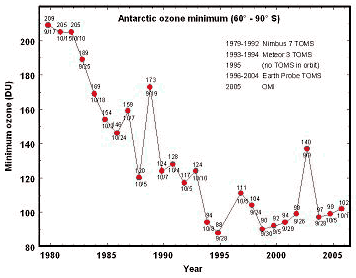Ozone stops declining while climate warms
What the science says...
Multiple satellite measurements and ground-based observations have determined the ozone layer has stopped declining since 1995 while temperature trends continue upwards.
Climate Myth...
It's ozone
The Ozone Layer stops UV radiation from entering our atmosphere. As the ozone layer has been declining in recent decades, that may be causing global warming.
Multiple satellite measurements and ground-based observations have determined the ozone layer has stopped declining since 1995 (Yang et al. 2006) while temperature trends continue upwards.

Figure 1: Antarctic ozone minimum (Atmoz).
Last updated on 4 November 2016 by John Cook. View Archives































 Arguments
Arguments

































[DB] Actually, the chart does nothing to explain Arctic ozone holes, as the chart above deals with the Antarctic. :)
The Arctic ozone hole that formed this winter (2010/2011) was primarily due to prolonged cold in the stratosphere during the long Arctic winter:
"at some altitudes, the cold period in the Arctic lasted more than 30 days longer in 2011 than in any previously studied Arctic winter, leading to the unprecedented ozone loss"
This NOAA page does an excellent job differentiating between the Antarctic and Arctic ozone depletions.
Note that stratospheric cooling is an expected effect of AGW...
Recommended supplemnental reading:
Closing the Ozone Hole Helped Slow Arctic Warming by Chelsea Harvey, E&E News/Scientific American, Jan 22, 2020